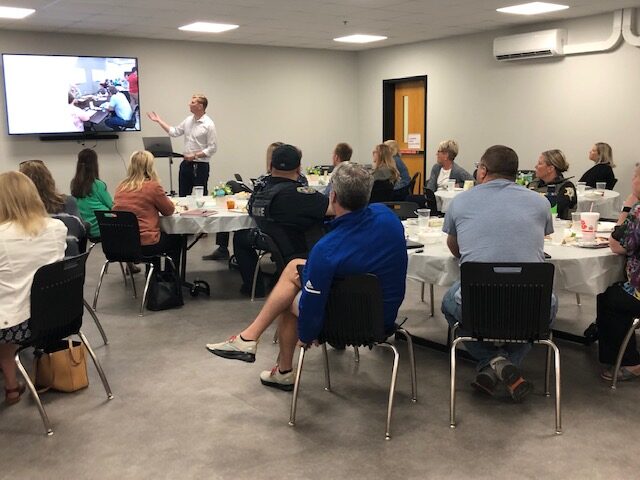Blog
Meeting Of The Minds, Sharing Findings From Youth Summit

Seven months had passed since that warm October day. In between these dates. For the youth summit participants academic successes mingled with athletic contests, social gatherings and future planning had occurred.
During this time, by a detailed process, Dr. James Proszek and the fellows of the Wabash Democracy and Public Discourse initiative had derived findings from the first Montgomery County Youth Summit. Similarly, the Wabash team had distilled all the energetic discourse from a March Middle-Level summit.
Having read the reports themselves, the members of the Wellness Coalition Mind Committee believed that the information gleaned from these first youth summits would be of interest to the adults who are invested in the present happiness and future success of these young people. Thus, adult stakeholders joined the Mind Committee at a mid-June luncheon, dubbed as the “Meeting of the Minds,” to learn the outcomes of the youth summit.
Administrators from all three Montgomery County school corporations, each of the school resource officers, plus members of the Montgomery County Community Foundation, United Way, and Montgomery County Health Department learned the process through which the data had been collected.
How the deliberative approach of the youth summit differs from some other data-producing instruments is that the framing questions are more general, and the responses evolve through the discussions. For example, a written standardized survey might pose a question, such as: “Have you consumed alcohol in the last month?” (Indiana Youth Survey) to which the respondent would answer yes or no. In a youth summit setting, students as members of a group might respond to an open-ended question such as: “What substances do you think high school students might use to cope with mental health struggles?” (Wabash DPD) and be able to elaborate on their views.
In the Montgomery County Youth Summit deliberations, Dr. Proszek shared that Youth Summit participants described a wide range of situations in school and at home that negatively affect their mental health.
For middle-level students, bullying was reported as an issue negatively affecting mental health. Different types of bullying were cited, including harmful joking framed as playfulness, cyberbullying on social media, and race and class-based slurs.
Middle-schoolers described the problem of bullying from a range of perspectives. Some students expressed difficulty removing themselves from a bullying situation and/or reporting bullying to a teacher or counselor due to fear of negative social repercussions. Some identified that bullying could lead to self-harm, and others expressed fear about parents and friends discovering that the individual had been a victim of physical, verbal, or cyberbullying.
The age group experiences of each summit’s participants resulted in different concerns. For example, high school students, in their post-summit written reflections showed bullying to be one of the lesser worries for that age group.
Of great concern for high school summit attendees was stress. Management of academic workload and balancing social and extracurricular activities with schoolwork caused stress for the high school age students. They were also concerned about dealing with social stigmas surrounding mental health and making sure they are mentally and emotionally well-equipped to handle what the future may hold for them after high school.
Additional themes from the deliberations were discussed with the stakeholders at the June luncheon and have also been shared with them in a written report. It is hoped that each school corporation will have future opportunities to delve into the findings and determine how they may address their own students’ concerns.
One potentially powerful component of the luncheon was the opportunity for individuals in parallel student service positions across the county to discuss the data that was shared through the report. One evaluation respondent observed, “I enjoyed the time and space to sit and speak with so many other professionals. I look forward to this continuing and having a more robust data set as the process is refined.” Another participant agreed: “I think we need to have more of these meetings where all schools can collaborate together to better help the youth in our community.”
